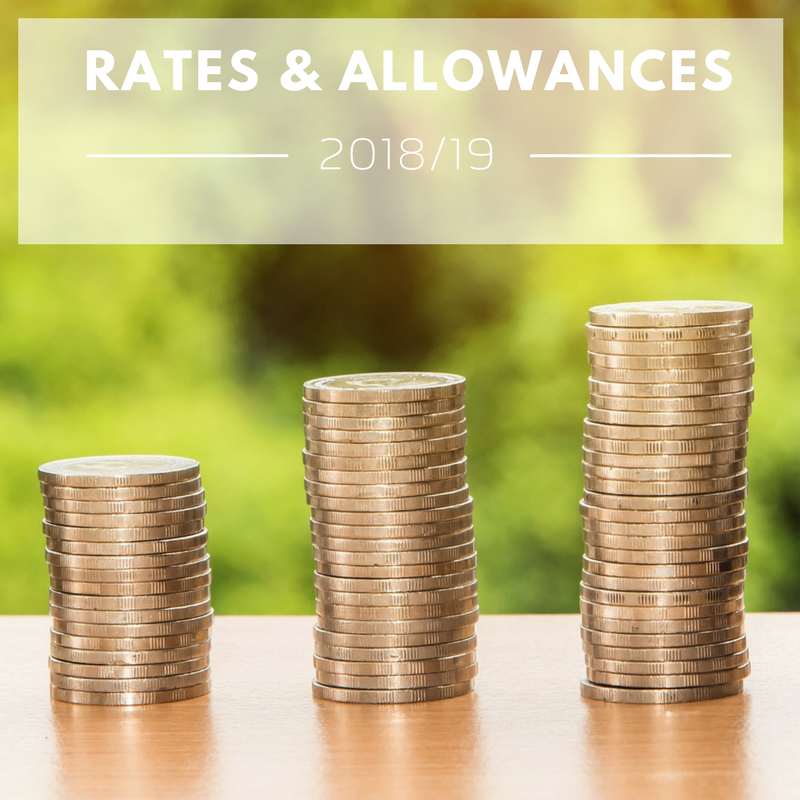With the new year brings many changes and in this post, you can find out all about the tax rates and allowances that will apply for the year 2018/19 as well as changes to the income tax bands for Scottish tax payers.
Personal allowance
The personal allowance increases to £11,850 for the 2018/19 tax year. As for 2017/18, the personal allowance is reduced by £1 for every £2 by which adjusted net income exceeds £100,000. This means that anyone with income in excess of £123,700 in 2018/19 will not receive a personal allowance.
Marriage allowance
The marriage allowance – set at 10% of the personal allowance – is increased to £1,185 for 2018/19. Changes are being made to the rules to allow a claim to be made in respect of a deceased spouse or civil partner, and for claims to be back-dated four years.
Income tax rates and thresholds
The basic rate band is increased to £34,500 for 2018/19, raising the rate at which higher rate tax becomes payable to £46,350. As for 2017/18, the additional rate threshold remains at £150,000.
The rates of income tax in the UK (excluding Scotland) are unchanged for 2018/19, with the basic rate remaining at 20%, the higher rate at 40% and the additional rate at 45%.
New income tax bands in Scotland
Two new income tax bands – a starter band and an intermediate band – are to be introduced in Scotland for 2018/19. For 2018/19, Scottish taxpayers will pay tax at the starter rate of 19% on income in excess of the personal allowance of £11,850 up to £13,850, basic rate tax at 20% is payable on income from £13,851 to £24,000, tax at the intermediate rate of 21% is payable on income above £24,000 up to £44,273, tax at the higher rate of 41% is payable on income above £44,273 up to £150,000 and tax is payable at the top rate of 46% on income over £150,000.
Dividend tax
The dividend tax rates for 2018/19 remain at 7.5% to the extent that dividend income falls in the basic rate band, at 32.5% to the extent that dividend income falls in the higher rate band, and at 38.1% to the extent that dividend income falls in the additional rate band. However, the dividend allowance – the band within which dividends are taxed at a zero rate – falls from £5,000 to £2,000 from 6 April 2018.
Savings
The savings allowance remains at £1,000 for basic rate taxpayers and at £500 for higher rate taxpayers for 2018/19. As for 2017/18, additional rate taxpayers do not benefit from a tax-free savings allowance.
The savings rate of tax remains at 0% on the first £5,000. The savings rate is restricted by non-savings income and the benefit of the 0% rate is lost if taxable non-savings income is more than £5,000.
Capital gains tax
The exempt amount for capital gains tax purposes is increased to £11,700 for 2018/19. The rates of capital gains tax remain at 10% to the extent that total taxable income and gains does not exceed the basic rate limit and at 20% where income and gains are more than the basic rate limit. Higher rates of, respectively, 18% and 28%, apply to gains on residential property.
Corporation tax
The rate of corporation tax for the financial year 2018 (the year starting on 1 April 2018) remains at 19%.
VAT threshold
The VAT threshold is frozen at its current level of £85,000 for two years from 1 April 2018. The VAT de-registration threshold remains at £83,000.
National Insurance contributions
For 2018/19 the lower earnings limit for Class 1 National Insurance purposes is increased to £116 per week, the primary and secondary thresholds are increased to £162 per week and the upper earnings limit is increased to £892 per week. The upper secondary threshold for under 21s and the apprentice upper secondary threshold, both aligned with the upper earnings limit, increase to £892 per week for 2018/19.
The main primary rate of Class 1 contributions remains at 12%, the additional rate remains at 2% and the secondary rate remains at 13.8%.
The National Insurance employment allowance remains at £3,000 for 2018/19.
The Class 2 small profits limit rises to £6,205 for 2018/19 and the weekly rate of Class 2 contributions increases to £2.95 per week.
The rate of voluntary Class 3 contributions increases to £14.65 per week for 2018/19.
The lower profits limit for Class 4 contributions increases to £8,424 for 2018/19 and the upper profits limit increases to £46,350. The main rate of Class 4 contributions remains at 9% and the additional rate remains at 2%.
If you would like any further advice or guidance on this, then please do not hesitate to get in touch with us.




